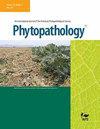Saskia Desiree Mesquida-Pesci, Abraham Morales-Cruz, Silvia Rodriguez-Pires, Rosa Figueroa-Balderas, Christian James Silva, Adrian Sbodio, Elia Gutierrez-Baeza, Petros Martin Raygoza, Dario Cantu, Barbara Blanco-Ulate
求助PDF
{"title":"<i>Rhizopus stolonifer</i> Exhibits Necrotrophic Behavior when Causing Soft Rot in Ripe Fruit.","authors":"Saskia Desiree Mesquida-Pesci, Abraham Morales-Cruz, Silvia Rodriguez-Pires, Rosa Figueroa-Balderas, Christian James Silva, Adrian Sbodio, Elia Gutierrez-Baeza, Petros Martin Raygoza, Dario Cantu, Barbara Blanco-Ulate","doi":"10.1094/PHYTO-03-24-0081-R","DOIUrl":null,"url":null,"abstract":"<p><p><i>Rhizopus stolonifer</i> is known for causing soft rot in fruits and vegetables during postharvest. Although it has traditionally been considered a saprophyte, it appears to behave more like a necrotrophic pathogen. In this study, we propose that <i>R</i>. <i>stolonifer</i> invades host tissues by actively killing host cells and overcoming the host defense mechanisms, as opposed to growing saprophytically on decaying plant matter. We tested this hypothesis by characterizing <i>R</i>. <i>stolonifer</i> infection strategies when infecting four fruit hosts (tomato, grape, strawberry, and plum). We started by generating a high-quality genome assembly for <i>R</i>. <i>stolonifer</i> using PacBio sequencing. This led to a genome size of 45.02 Mb, an N50 of 2.87 Mb, and 12,644 predicted loci with protein-coding genes. Next, we performed a transcriptomic analysis to identify genes that <i>R</i>. <i>stolonifer</i> preferentially uses when growing in fruit versus culture media. We categorized these infection-related genes into clusters according to their expression patterns during the interaction with the host. Based on the expression data, we determined that <i>R</i>. <i>stolonifer</i> has a core infection toolbox consisting of strategies typical of necrotrophs, which includes a set of 33 oxidoreductases, 7 proteases, and 4 cell wall-degrading enzymes to facilitate tissue breakdown and maceration across various hosts. This study provides new genomic resources for <i>R</i>. <i>stolonifer</i> and advances the knowledge of <i>Rhizopus</i>-fruit interactions, which can assist in formulating effective and sustainable integrated pest management approaches for soft rot prevention. [Formula: see text] Copyright © 2025 The Author(s). This is an open access article distributed under the CC BY 4.0 International license.</p>","PeriodicalId":20410,"journal":{"name":"Phytopathology","volume":" ","pages":"306-315"},"PeriodicalIF":2.6000,"publicationDate":"2025-03-01","publicationTypes":"Journal Article","fieldsOfStudy":null,"isOpenAccess":false,"openAccessPdf":"","citationCount":"0","resultStr":null,"platform":"Semanticscholar","paperid":null,"PeriodicalName":"Phytopathology","FirstCategoryId":"97","ListUrlMain":"https://doi.org/10.1094/PHYTO-03-24-0081-R","RegionNum":2,"RegionCategory":"农林科学","ArticlePicture":[],"TitleCN":null,"AbstractTextCN":null,"PMCID":null,"EPubDate":"2025/3/20 0:00:00","PubModel":"Epub","JCR":"Q2","JCRName":"PLANT SCIENCES","Score":null,"Total":0}
引用次数: 0
引用
批量引用
Abstract
Rhizopus stolonifer is known for causing soft rot in fruits and vegetables during postharvest. Although it has traditionally been considered a saprophyte, it appears to behave more like a necrotrophic pathogen. In this study, we propose that R . stolonifer invades host tissues by actively killing host cells and overcoming the host defense mechanisms, as opposed to growing saprophytically on decaying plant matter. We tested this hypothesis by characterizing R . stolonifer infection strategies when infecting four fruit hosts (tomato, grape, strawberry, and plum). We started by generating a high-quality genome assembly for R . stolonifer using PacBio sequencing. This led to a genome size of 45.02 Mb, an N50 of 2.87 Mb, and 12,644 predicted loci with protein-coding genes. Next, we performed a transcriptomic analysis to identify genes that R . stolonifer preferentially uses when growing in fruit versus culture media. We categorized these infection-related genes into clusters according to their expression patterns during the interaction with the host. Based on the expression data, we determined that R . stolonifer has a core infection toolbox consisting of strategies typical of necrotrophs, which includes a set of 33 oxidoreductases, 7 proteases, and 4 cell wall-degrading enzymes to facilitate tissue breakdown and maceration across various hosts. This study provides new genomic resources for R . stolonifer and advances the knowledge of Rhizopus -fruit interactions, which can assist in formulating effective and sustainable integrated pest management approaches for soft rot prevention. [Formula: see text] Copyright © 2025 The Author(s). This is an open access article distributed under the CC BY 4.0 International license.
根瘤菌(Rhizopus stolonifer)在引起成熟水果软腐病时表现出坏死性。
众所周知,匍匐茎霉会在水果和蔬菜收获后引起软腐病。虽然它传统上被认为是腐生植物,但它的行为似乎更像是一种坏死性病原体。在本研究中,我们提出匍匐茎通过主动杀伤宿主细胞和克服宿主防御机制侵入宿主组织,而不是在腐烂的植物物质上腐生生长。我们通过对四种水果寄主(番茄、葡萄、草莓和李子)的侵染策略进行表征,验证了这一假设。我们首先使用PacBio测序技术生成了高质量的匍匐茎基因组组装。这导致基因组大小为45.02 Mb, N50为2.87 Mb,蛋白质编码基因预测位点为12,644个。接下来,我们进行了转录组学分析,以确定匍匐茎在果实和培养基中生长时优先使用的基因。我们根据这些感染相关基因在与宿主相互作用过程中的表达模式将它们分类成簇。基于表达数据,我们确定匍匐茎具有一个核心感染工具箱,包括一组33个氧化还原酶,7个蛋白酶和4个细胞壁降解酶,以促进不同宿主的组织分解和浸渍。该研究为匍匐茎提供了新的基因组资源,促进了对根霉与果实相互作用的认识,有助于制定有效和可持续的软腐病综合防治方法。
本文章由计算机程序翻译,如有差异,请以英文原文为准。

 求助内容:
求助内容: 应助结果提醒方式:
应助结果提醒方式:


